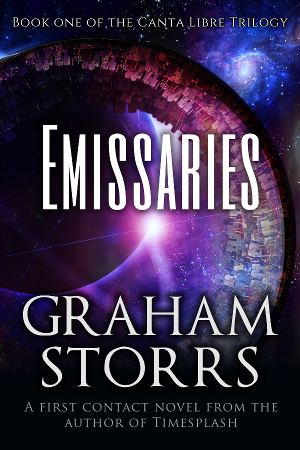Why I had to Invent a Star Drive
It’s great that there are so many planets in the galaxy. We’ve spotted thousands already and current estimates are that there are about two planets per star (+/- 1) and possibly 1 Earth-like planet for every 5 stars. There could be as many as 200 billion stars in our galaxy, meaning we might be sharing the Milky Way with 10 billion Earth-like planets. As I said, great, but the downside is that they’re all so very far away.
And even that’s not such a big problem, unless you happen to be writing a space opera. Then all the light years between Earth-like planets start to add up. In our local stellar neighbourhood, the stars are about 3 light years apart. Our nearest neighbour is actually farther away than that at 4.2 light years. Rockets, even fusion rockets, are barely adequate for chugging around our own solar system. A fusion rocket trip from here to Jupiter would still take us a year, and to Saturn, maybe 2 years. With other kinds of technologies we can envisage now – and might be able to build in the next fifty years, say – we could get to the next star in a few decades at best (using maser-propelled sails, for example). It’s all so slow!
 So, if you’re writing a space opera, you need something with a bit more oomph. Rockets are great, they give you plenty of acceleration, but they work by throwing stuff (reaction mass) out the back at high speeds. Pretty soon, you run out of stuff to throw. To accelerate to significant fractions of the speed of light – say 50%, where relativistic effects can be felt, and the eight-year trip to Alpha Centauri A only feels like a bit under seven years – requires you to keep burning fuel for a long time, especially when you’re pushing a spaceship that can keep people alive for seven years. In fact, you need so much reaction mass that the whole thing becomes impractical. Ion drives or electric drives are more efficient for long journeys but they accelerate so very slowly that you could die of old age waiting for them to get up to a reasonable fraction of light speed.
So, if you’re writing a space opera, you need something with a bit more oomph. Rockets are great, they give you plenty of acceleration, but they work by throwing stuff (reaction mass) out the back at high speeds. Pretty soon, you run out of stuff to throw. To accelerate to significant fractions of the speed of light – say 50%, where relativistic effects can be felt, and the eight-year trip to Alpha Centauri A only feels like a bit under seven years – requires you to keep burning fuel for a long time, especially when you’re pushing a spaceship that can keep people alive for seven years. In fact, you need so much reaction mass that the whole thing becomes impractical. Ion drives or electric drives are more efficient for long journeys but they accelerate so very slowly that you could die of old age waiting for them to get up to a reasonable fraction of light speed.
So sci-fi writers have long dreamt of rockets that gather reaction mass from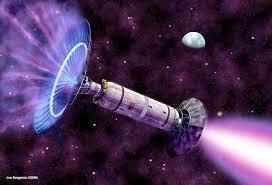 space itself as they go along, using gigantic magnetic “scoops” to funnel hydrogen into their fuel tanks. A little-known piece of Star Trek trivia is that the glowing tips on the warp nacelles on a starship are supposed to represent the scoops in action. Sadly, the reality of the situation is that the density of material in open space is so low, it would take an electromagnetic scoop the size of the Earth to gather a single kilogram of hydrogen! Also, gigantic scoops feel drag due to the interstellar medium and this tends to exceed the thrust you can generate under reasonable assumptions.
space itself as they go along, using gigantic magnetic “scoops” to funnel hydrogen into their fuel tanks. A little-known piece of Star Trek trivia is that the glowing tips on the warp nacelles on a starship are supposed to represent the scoops in action. Sadly, the reality of the situation is that the density of material in open space is so low, it would take an electromagnetic scoop the size of the Earth to gather a single kilogram of hydrogen! Also, gigantic scoops feel drag due to the interstellar medium and this tends to exceed the thrust you can generate under reasonable assumptions.
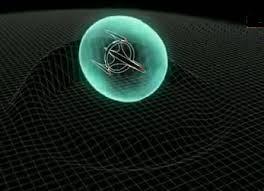 In fact, it all looks pretty hopeless – until you start thinking about warping space. There’s an idea out there, attributed to Miguel Alcubierre, that if you can configure an energy density field around your spaceship in a very specific way, you can contract space ahead of the ship and expand it behind. It’s as if you are static within a bubble of space which, because of its distorted edges, moves through normal space (or moves normal space past the ship!) No-one is going faster than light in their local space-time frame of reference, but the bubble itself can move faster than light. (It’s a relativity thing. If you want to know more, you’re going to have to look it up.) It’s a dodgy idea since it might need vast amounts of negative energy to make it work (and we have no idea how to create or use negative energy). Also, if quantum gravity turns out to be the grand unifying theory some hope it is, Alcubierre’s idea wouldn’t work anyway.
In fact, it all looks pretty hopeless – until you start thinking about warping space. There’s an idea out there, attributed to Miguel Alcubierre, that if you can configure an energy density field around your spaceship in a very specific way, you can contract space ahead of the ship and expand it behind. It’s as if you are static within a bubble of space which, because of its distorted edges, moves through normal space (or moves normal space past the ship!) No-one is going faster than light in their local space-time frame of reference, but the bubble itself can move faster than light. (It’s a relativity thing. If you want to know more, you’re going to have to look it up.) It’s a dodgy idea since it might need vast amounts of negative energy to make it work (and we have no idea how to create or use negative energy). Also, if quantum gravity turns out to be the grand unifying theory some hope it is, Alcubierre’s idea wouldn’t work anyway.
Yet, while there’s uncertainty and doubt, there’s still enough wriggle-room for a sci-fi writer like me to slap Alcubierre drives into space ships and send them off into the void. Trouble is, even these faster-than-light marvels of a future age may be too slow for what I need. It’s hard to say what kind of speeds might reasonably be expected from a warp drive. 3c (3 times the speed of light) seems to be a general consensus, with it possibly going all the way up to 10c. Now ten times the speed of light is really motoring. You get to Alpha Centauri in about five months, Gliese 581 (where we know there is an Earth-sized planet) in about two-and-a-half years. If you want to colonise all the nearby stellar systems, the Alcubierre drive is the man for the job. But what if you want to go a little farther, to Gamma Sagittae, for example, just 273 light years away? You’re back to taking decades again. And Gamma Sagittae is practically on our doorstep compared to size of the galaxy.
Yet, if you want to go faster than that, modern scientists shrug their shoulders and turn away. “Space is big,” they tell you. “Really big. You just won’t believe how vastly, hugely, mindbogglingly big it is.” Being scientists, they like quoting Douglas Adams. They also like to accept the prevailing paradigm, until someone brighter than they are runs a truck through it.
But sci-fi writers are made of sterner stuff and, besides, we have stories to tell that won’t wait decades or centuries while all those geniuses clamber slowly up onto the shoulders of giants. If you want to go faster than 10c, you’ve just got to make stuff up – but plausible-sounding stuff, not just any old stuff, or you might as well be writing fantasy.
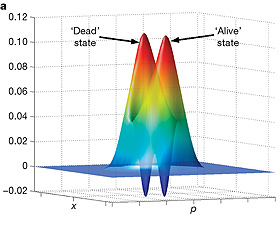 Those of you who know anything about quantum theory know that quite a lot of it sounds like the ravings of a madman. Particles have some probability of being everywhere in the universe at once, they can teleport through matter, the absence of a particle can behave just like a particle, they pop out of nothing in pairs and immediately annihilate one another, they can be in many states at the same time, they’re not just particles, they’re also waves, but not waves in anything, and so on. It’s crazy and, moreover, no-one can give a clear and complete description of the world based on quantum theory – which is why a number of different interpretations of it have arisen.
Those of you who know anything about quantum theory know that quite a lot of it sounds like the ravings of a madman. Particles have some probability of being everywhere in the universe at once, they can teleport through matter, the absence of a particle can behave just like a particle, they pop out of nothing in pairs and immediately annihilate one another, they can be in many states at the same time, they’re not just particles, they’re also waves, but not waves in anything, and so on. It’s crazy and, moreover, no-one can give a clear and complete description of the world based on quantum theory – which is why a number of different interpretations of it have arisen.
The Copenhagen interpretation, for example, says that reality is fundamentally non-deterministic and the probabilities and uncertainties of quantum theory are a true reflection of the world but that, moment-to-moment, those vast inherent uncertainties are being “collapsed” into the single universe we are aware of as quantum particles interact to “decohere” their “superposed” states. The many worlds interpretation says that the universe we know is one of a possibly infinite number and is everywhere forking off into new universes, one for every possibility implied by the uncertainties of every quantum particle. No one universe is therefore non-deterministic, but the universe you end up in could not have been determined.
The interpretation Einstein preferred for all this quantum weirdness is known as a hidden variable interpretation. It’s simple.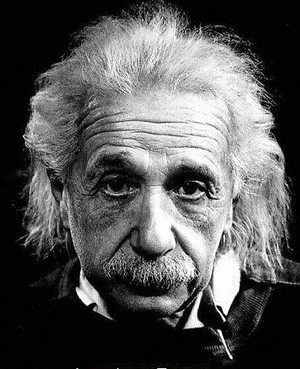 It says we can’t predict what the quantum world is going to do because we don’t have all the information. There are variables at play that are hidden from us. There has been heated debate about hidden variable theories and one type (local hidden variable theories) may well have been rule out experimentally (though maybe not), leaving only non-local hidden variables as possible contenders. Indeed, David Bohm’s “causal” interpretation is one such model that still stands unchallenged.
It says we can’t predict what the quantum world is going to do because we don’t have all the information. There are variables at play that are hidden from us. There has been heated debate about hidden variable theories and one type (local hidden variable theories) may well have been rule out experimentally (though maybe not), leaving only non-local hidden variables as possible contenders. Indeed, David Bohm’s “causal” interpretation is one such model that still stands unchallenged.
So let’s fast-forward 200 years to a new and amazing breakthrough in physics – a detailed non-local hidden variable theory of physics has been demonstrated to be the best possible fit to all physical phenomena – subsuming quantum theory and relativity. Indeed, the world of these hidden variables has been dubbed “infra-reality”. A hundred years after that, physicists have finally learned how to manipulate infra-reality and the results are fabulous new technologies which would have seemed almost magical to primitives like ourselves. At last, I have the opportunity to create the star drive I’ve always wanted. To explain it, let’s go inside the mind of physicist Susan Iverson, a character in my new novel, Emissaries, as she waits to take off in the spaceship Canta Libre and ponders the physics of the ship’s prototype infra-reality (IR) drive.
Susan Iverson was not feeling so confident. She found herself gripping the arms of her couch as the timer counted down to the transition. She had been reviewing the physics of space-time tunnelling (‘stunnelling’ in the jargon of the field) and she was well aware of how many theoretical questions remained to be answered. She wished again that they weren’t using such a pioneering technology. The traditional space-warping techniques had been in use for over a hundred years and it was safer to travel that way even than by fusion rocket.
One minute to go.
Stunnelling relied on Osamoto’s IR equations. They too had been known for a hundred years and IR was as well-established as any theory had ever been. The host of IR effect products on the market, the very gravity she was experiencing, were proof that it worked. Yet…
She considered the effect as it was applied by the ship and shuddered. By the usual magic of IR, a gravitational force was created, effectively warping space around and ahead of the ship, not into a gentle ripple they could surf in the usual way but radically and violently, into a short tunnel – what would have been called a wormhole in past times. The tunnel connected the space around the Canta Libre with the space a minute distance ahead of it – just ten zeptometres ahead in fact – about a thousandth of the width of an atomic nucleus. The ‘depth’ of the stunnel, in the reality perceived by everyone outside it, appeared to be just one Plank length, the smallest length it could be. The ship sailed through the stunnel at sublight speeds (thirty thousand metres per second being the maximum permitted by theory for reasons even Osamoto could not understand) but a new stunnel kept opening just ahead of the ship. So the ship kept stealing those ten zeptometres for every Plank length that it seemed to be moving. The stability of the stunnel was the problem. Keeping one open was a delicate business and nothing she had read could convince her that the technology existed to do this reliably. Of course, her calculations showed that, even if the stunnel collapsed, they would only lose the first ten zeptometres of their ship’s nose – an amount so small they wouldn’t be able to detect it. Either that or they would be spread like a fine gas across millions of kilometres. It all depended on the size of a particular constant that nobody had yet worked out. All in all, she would rather that someone else was aboard the first stunnelling interstellar flight instead of her.
It’s so nice to be able to just make up physics when the physics we have just isn’t up to the job. The multiplication factor achieved by this strange application of an invented physics, allows a ship to travel at 1,000 times the speed of light. now you can get to Gamma Sagittae in three months and out to the planetary nebula, M27, in fifteen months. You could cross the whole galaxy from end to end in a hundred years or so! Perfect for a space opera. Suddenly I’m free to go where no one has gone before – in any ship half as plausible as this one, that is.


